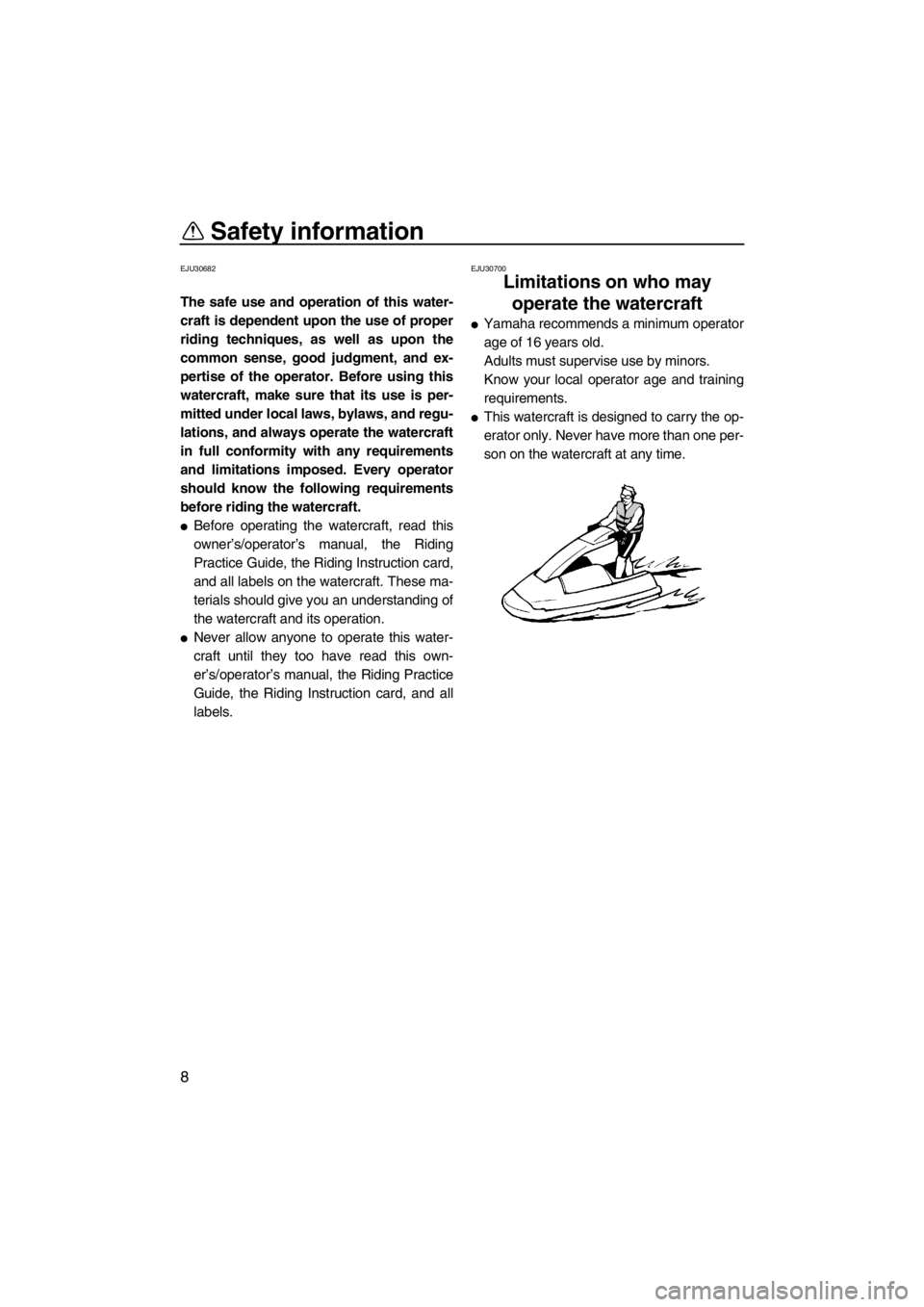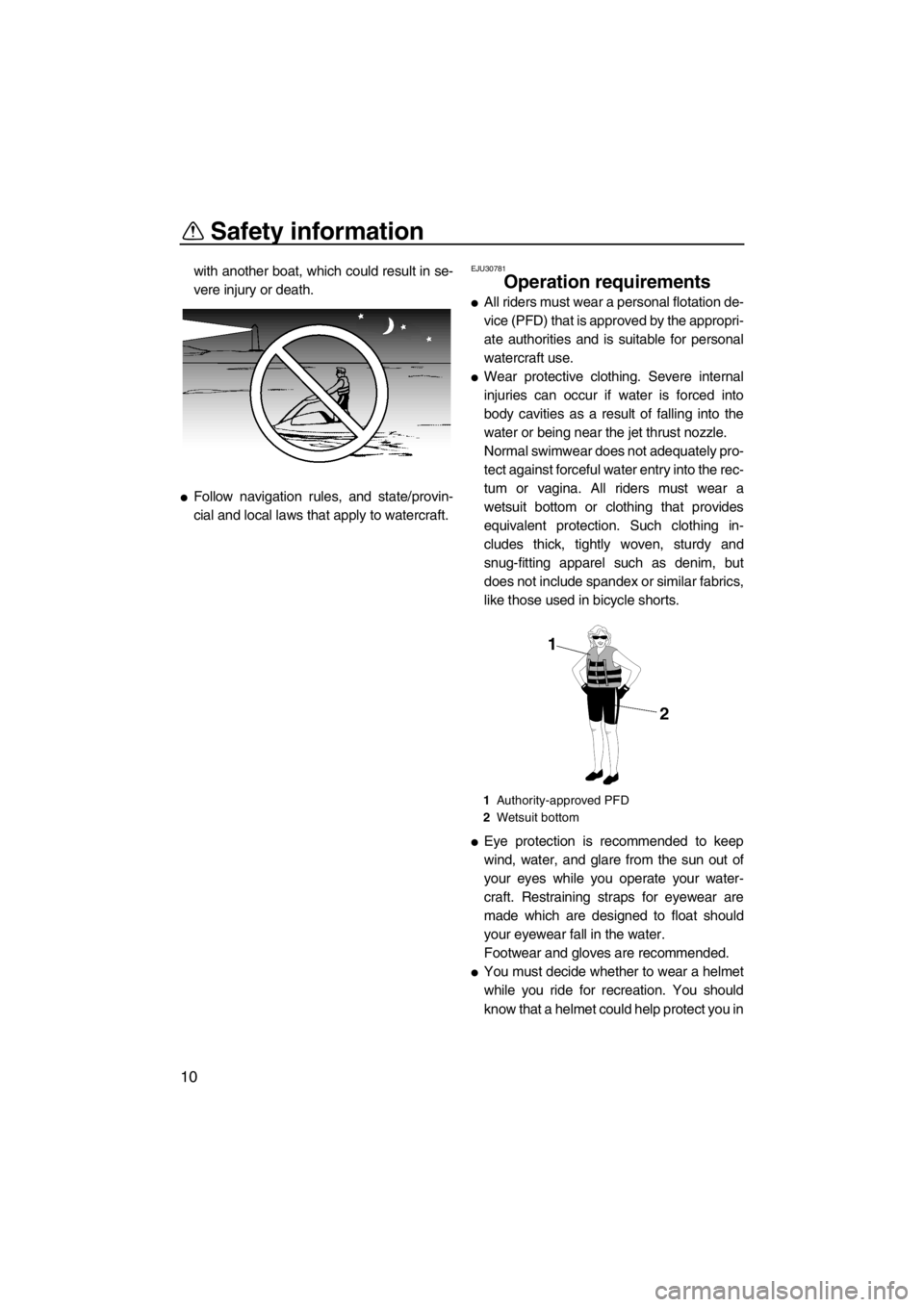Page 9 of 78
General and important labels
3
EJU30452
Important labels
Read the following labels before using this watercraft. If have any questions, consult a Yamaha
dealer.
UF2F75E0.book Page 3 Thursday, July 5, 2012 8:50 AM
Page 10 of 78
General and important labels
4
EJU35913Warning labels
If any of these labels are damaged or missing, contact a Yamaha dealer for replacements.
UF2F75E0.book Page 4 Thursday, July 5, 2012 8:50 AM
Page 11 of 78
General and important labels
5
UF2F75E0.book Page 5 Thursday, July 5, 2012 8:50 AM
Page 12 of 78
General and important labels
6
UF2F75E0.book Page 6 Thursday, July 5, 2012 8:50 AM
Page 13 of 78
General and important labels
7
EJU35925Other labels
The following label indicates the correct direction to upright a capsized watercraft.
F2F-6418F-00
15
UF2F75E0.book Page 7 Thursday, July 5, 2012 8:50 AM
Page 14 of 78

Safety information
8
EJU30682
The safe use and operation of this water-
craft is dependent upon the use of proper
riding techniques, as well as upon the
common sense, good judgment, and ex-
pertise of the operator. Before using this
watercraft, make sure that its use is per-
mitted under local laws, bylaws, and regu-
lations, and always operate the watercraft
in full conformity with any requirements
and limitations imposed. Every operator
should know the following requirements
before riding the watercraft.
●Before operating the watercraft, read this
owner’s/operator’s manual, the Riding
Practice Guide, the Riding Instruction card,
and all labels on the watercraft. These ma-
terials should give you an understanding of
the watercraft and its operation.
●Never allow anyone to operate this water-
craft until they too have read this own-
er’s/operator’s manual, the Riding Practice
Guide, the Riding Instruction card, and all
labels.
EJU30700
Limitations on who may operate the watercraft
●Yamaha recommends a minimum operator
age of 16 years old.
Adults must supervise use by minors.
Know your local operator age and training
requirements.
●This watercraft is designed to carry the op-
erator only. Never have more than one per-
son on the watercraft at any time.
UF2F75E0.book Page 8 Thursday, July 5, 2012 8:50 AM
Page 15 of 78

Safety information
9
EJU30761
Cruising limitations
●Scan constantly for people, objects, and
other watercraft. Be alert for conditions that
limit your visibility or block your vision of
others.
●Operate defensively at safe speeds and
keep a safe distance away from people, ob-
jects, and other watercraft.
●Do not follow directly behind watercraft or
other boats.
●Do not go near others to spray or splash
them with water.
●Avoid sharp turns or other maneuvers that
make it hard for others to avoid you or un-
derstand where you are going.
●Avoid areas with submerged objects or
shallow water.
●Take early action to avoid collisions. Re-
member, watercraft and other boats do not
have brakes.
●Do not release the throttle lever when trying
to steer away from objects—you need throt-
tle to steer. Always check throttle and steer-
ing controls before starting the watercraft.
●Ride within your limits and avoid aggressive
maneuvers to reduce the risk of loss of con-
trol, ejection, and collision.
●This is a high performance boat—not a toy.
Sharp turns or jumping wakes or waves can
increase the risk of back/spinal injury (pa-
ralysis), facial injuries, and broken legs, an-kles, and other bones. Do not jump wakes
or waves.
●Do not operate the watercraft in rough wa-
ter, bad weather, or when visibility is poor;
this may lead to an accident causing injury
or death. Be alert to the possibility of ad-
verse weather. Take note of weather fore-
casts and the prevailing weather conditions
before setting out on your watercraft.
●As with any water sport, you should not op-
erate your watercraft without someone else
nearby. If you operate further than swim-
ming distance from shore, you should be
accompanied by another boat or watercraft,
but make sure you stay a safe distance
away. It’s good, common sense.
●Never operate in water that is less than 60
cm (2 ft) deep from the bottom of the water-
craft, otherwise you increase your chance
of hitting a submerged object, which could
result in injury.
●This watercraft is not equipped with lighting
required for night operation. Do not operate
the watercraft after sunset or before dawn,
otherwise you increase the risk of colliding
UF2F75E0.book Page 9 Thursday, July 5, 2012 8:50 AM
Page 16 of 78

Safety information
10
with another boat, which could result in se-
vere injury or death.
●Follow navigation rules, and state/provin-
cial and local laws that apply to watercraft.
EJU30781
Operation requirements
●All riders must wear a personal flotation de-
vice (PFD) that is approved by the appropri-
ate authorities and is suitable for personal
watercraft use.
●Wear protective clothing. Severe internal
injuries can occur if water is forced into
body cavities as a result of falling into the
water or being near the jet thrust nozzle.
Normal swimwear does not adequately pro-
tect against forceful water entry into the rec-
tum or vagina. All riders must wear a
wetsuit bottom or clothing that provides
equivalent protection. Such clothing in-
cludes thick, tightly woven, sturdy and
snug-fitting apparel such as denim, but
does not include spandex or similar fabrics,
like those used in bicycle shorts.
●Eye protection is recommended to keep
wind, water, and glare from the sun out of
your eyes while you operate your water-
craft. Restraining straps for eyewear are
made which are designed to float should
your eyewear fall in the water.
Footwear and gloves are recommended.
●You must decide whether to wear a helmet
while you ride for recreation. You should
know that a helmet could help protect you in
1Authority-approved PFD
2 Wetsuit bottom
UF2F75E0.book Page 10 Thursday, July 5, 2012 8:50 AM